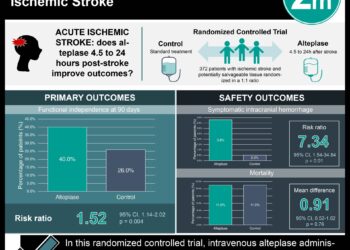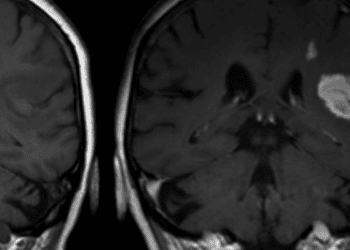Post-procedure stroke rates stable in TAVR patients in United States
1. In this retrospective cohort study, the rate of 30-day post-procedure stroke after transcatheter aortic valve replacement (TAVR) remained stable during the first five years of US clinical practice.
2. 30-day stroke rates were similar between patients who received dual antiplatelet therapy, oral anticoagulants, or neither at hospital discharge.
Evidence Rating Level: 2 (Good)
Study Rundown: Transcatheter aortic valve replacement (TAVR) is a widely adopted approach that was approved by the US Food and Drug Administration (FDA) for patients with severe symptomatic aortic stenosis and at least intermediate surgical risk. The risk of stroke following TAVR is comparable to that of surgical aortic valve replacement, but as practice and technology have improved, it is unclear if stroke risk after TAVR has declined since its adoption. In this large, retrospective cohort study the rate of 30-day post-procedure stroke after TAVR remained stable during the first five years of US clinical practice. This was despite improvements in TAVR technology and operator experience. Most early post-TAVR strokes occurred within the first few days, and early stroke was independently associated with a significant increase in 30-day mortality. 30-day stroke rates were similar between patients who received dual antiplatelet therapy, oral anticoagulants, or neither at hospital discharge.
While this study suggests improvements in TAVR implementation have not greatly affected stroke risk, this study has several limitations. First, this is a registry-based study with use of voluntary site-reported neurologic events, and the registry does not mandate routine neurologic assessment or neuroimaging of asymptomatic patients. Second, the propensity-matched analyses of the association of anti-thrombotic medical therapies with 30-day neurologic event rates focused only on patients with events after hospital discharge. Lastly, this study focused on early neurologic events after TAVR and not with long-term neurologic risk.
Click to read the study in JAMA
Click to read an accompanying editorial in JAMA
In-Depth [retrospective cohort]: This study analyzed data from 101,430 patients who were treated with femoral and non-femoral TAVR at 521 US hospitals and in a national registry from November 9, 2011 through May 31, 2017. The rates of 30-day stroke, transient ischemic attack (TIA), and any neurologic event (stroke or TIA) were assessed. The study outcomes were trends in crude 30-day neurologic event rates over time, the association of post-TAVR 30-day stroke with mortality, and the association of antithrombotic medical therapy at discharge with stroke in the 30 days after discharge. There were 373 patients (0.4%) with TIA (CI95, 0.3 to 0.4%) and 2290 patients (2.3%) with stroke of any kind (CI95 2.2 to 2.4%). 30-day stroke rates were stable without an increasing or decreasing trend in all patients (p for trend = 0.22) and in the large femoral access subgroup (p trend = 0.47). The rate of 30-day mortality was significantly higher among patients with vs without 30-day strokes (16.7% [383 of 2290] vs 3.7% [3662 of 99 140]; p < .001). When comparing dual antiplatelet therapy and oral anticoagulant after propensity matching, there was no significant differences in the risk of post-discharge 30-day stroke, TIA, or any neurologic event between either treatment strategies and no drug administration (p > 0.05).
Image: PD
©2019 2 Minute Medicine, Inc. All rights reserved. No works may be reproduced without expressed written consent from 2 Minute Medicine, Inc. Inquire about licensing here. No article should be construed as medical advice and is not intended as such by the authors or by 2 Minute Medicine, Inc.









